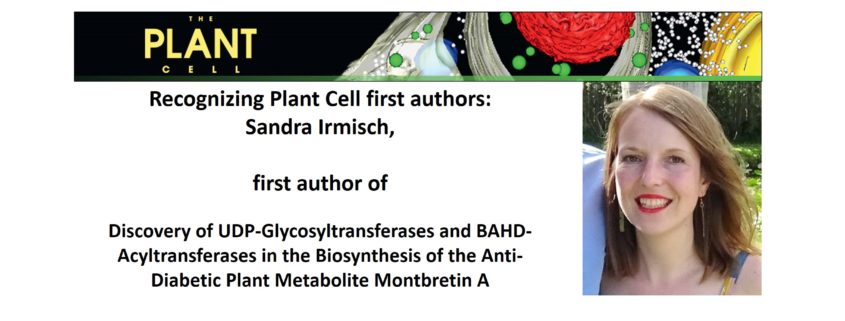Recognizing Plant Cell first authors: Sandra Irmisch
Sandra Irmisch, first author of Discovery of UDP-Glycosyltransferases and BAHD-Acyltransferases in the Biosynthesis of the Anti-Diabetic Plant Metabolite Montbretin A
Current Position: Postdoctoral Fellow in the laboratory of Joerg Bohlmann, Michael Smith Laboratories, University of British Columbia, BC, Canada
Education: PhD at the Max-Planck Institute for Chemical Ecology, Department of Biochemistry, Jena, Germany; MSc in Biochemistry at the Martin Luther University of Halle-Wittenberg
Other Interests: Hiking, traveling, dancing and cats
Brief Bio: I first came to appreciate the fascinating diversity of plant secondary metabolism during my MSc thesis while studying terpenes in camomile, a traditional medicinal plant. For my PhD thesis, under the mentorship of Dr. Jonathan Gershenzon and Dr. Tobias Koellner, I continued research on terpenes and extended my research into the less well known nitrogenous compounds that serve ecological roles as volatiles in poplar. Specifically, I discovered and characterized cytochrome P450 genes and enzymes in the biosynthesis of aldoximes and nitrile, which serve as herbivore induced compounds for indirect and direct defense. Much of this work of my PhD research was published in The Plant Cell. I was recognized for my PhD thesis with the prestigious Otto Hahn Medal awarded by the Max Planck Society. Supported with a Feodor Lynen Research Fellowship of the Alexander von Humboldt Foundation, I joined as a postdoctoral fellow the group of Dr. Joerg Bohlmann in the Michael Smith Laboratories at the University of British Columbia, Vancouver, Canada. At UBC I have been leading a group of graduate and undergraduate students to unveil the biosynthesis of the acylated flavonol glycoside montbretin A (MbA), an anti-diabetic compound produced in the ornamental plant montbretia. Our discoveries of the genes and enzymes of MbA biosynthesis are providing the tools for engineering a heterologous production system to enable a supply of MbA as a potential new drug for typ-2 diabetes treatment.



